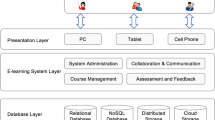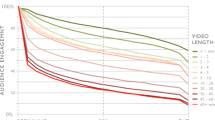Abstract
Distance learning has become a very important mechanism for virtual university operation. In order to realize such an operation smoothly, it is necessary to consider distance learning from three perspectives: administration, awareness, and assessment. We are currently implementing a virtual university environment according to these guidelines. In this paper, we propose part of such a supporting environment of the Multimedia Macro-University project.1 One of the most important focuses is a Web course development paradigm. Web documents are increasingly playing an important role in our daily life, as the Internet has become a new medium for communication and commerce. On the other hand, software development paradigms were developed to support program construction. However, these traditional paradigms do not completely fit the needs of Web document development due to the following reasons. Firstly, computer programs focus on problem solving, but Web documents focus on information delivery. Secondly, computer programs usually have a fixed size, but this is not true for Web documents, because Web documents are always evolving as if it were a living document. It is therefore necessary to investigate a new software development paradigm for developing Web documents. We propose such a new paradigm and its supporting environment, as well as software testing/metrics mechanisms for Web documents. The Web documents developed using our paradigm are stored in a Web documentation database. From a script description, to its implementation as well as testing records, the database and its interface allow the user to design Web documents as virtual courses to be used in a Web-savvy virtual library. The system is implemented as a three-tier architecture, which runs under MS Windows.
Similar content being viewed by others
References
Anthony, G. et al. (1987), “Reusability Issues and Ada,” IEEE Software, July, 43-51.
Bruce, A.B. et al. (1987), “The Reusable Software Library,” IEEE Software, July, 25-33.
Chang, S.K., E. Hassanein, and C.Y. Hsieh (1998), “A Multimedia Micro-University”, IEEE Multimedia Magazine 5, 3, 60-68.
Chen, T.C., W.P. Lin, C.A. Wu, and C.S. Shen (1994), “A Client-Server Database Environment for Supporting Multimedia Applications,” In Proceedings of the 18th IEEE Annual International Computer Software and Application Conference (COMPSAC'94), Taipei, Taiwan, pp. 215-220.
Chen, C.Y.R., S.M. Dikran, M.C.S. Chang and L.J. Liu (1995), “Design of a Multimedia Object-Oriented DBMS,” In Multimedia Systems, Vol. 3, Springer, pp. 217-227.
Chidamber, S.R. and C.F. Kemerer (1991a), “A Metrics Suite for Object Oriented Design,” IEEE Transactions on Software Engineering 20, 6, 476-493.
Chidamber, S.R. and C.F. Kemerer (1991b), “Towards a Metrics Suite for Object-Oriented Design,” In OOP-SLA'91 Proceedings, pp. 197-211.
Cho, J., M.H. Garcia and L. Page (1998), “Efficient Crawling through URL Ordering,” Computer Networks and ISDN Systems 30, 1-7, 161-172.
Chung, C.M., T.K. Shih, J.Y. Huang, Y.H. Wang, and T.F. Kuo (1995), “An Object-Oriented Approach and System for Intelligent Multimedia Presentation Designs,” In Proceedings of the IEEE International Conference on Multimedia Computing and Systems, pp. 278-281.
Dilley, J., R. Friedrich, J. Tai, and J. Rolia (1998), “Web Server Performance Measurement and Modeling Techniques,” Performance Evalutions 33, 1, 5-26.
Douglis, F., A. Feldmann, B. Krishnamurthy, and J. Mogul (1997), “Rate of Change and Other Metrics: A Live Study of the World-Wide Web,” In Proceedings of the USENIX Symposium on Internet Technologies and Systems, pp. 147-158.
Dunsmore, H.E. and J.D. Gannon, “Data Referencing: An Empirical Investigation,” IEEE Computer, 50-59.
Enn, T. (1991), “Three New-Generation Software Environments,” Communications of the ACM 34, 6, 46-59.
Enn, T. et al. (1986), “NUT-An Object-Oriented Language,” Computer and Artificial Intelligences 5, 6, 521-542.
Gerhard, F. (1987), “Cognitive View of Reuse and Redesign,” IEEE Software, July, 60-72.
Gerhard, A.S. and J.W. Michael (1995), “Presentation Layer Primitives for the Layered Multimedia Data Model,” In Proceedings of the IEEE 1995 International Conference on Multimedia Computing and Systems, May 15-18, Washington, DC, pp. 231-238.
Gibbs, S. (1991), “Composite Multimedia and Active Objects,” In ACM Object-Oriented Prog. System, Languages, and Application, pp. 97-112.
Heiko, T., M. Ulrich, R. Gunter, and M.W. Klaus (1996), “Distributed Multimedia Databases as Component of a Teleservice for Workflow Management,” In Proceedings of the 1996 Pacific Workshop on Distributed Multimedia Systems, Hong Kong, June 25-28, pp. 111-117.
Henda, H.B. et al. (1995), “A Reuse Approach Based on Object Orientation: Its Contributions in the Development of CASE Tools,” In Proceedings of the SSR'95 Conference, Seattle, WA, USA, pp. 53-62.
Horrison, W.A. and K.I. Magel, “A Complexity Measure Based on Nesting Level,” ACM SIGPLAN Notices 16, 3, 63-74.
Ivan, L.M.R. and C.M. Tobar (1996), “Towards an Architecture for Distributed Multimedia Databases,” In Proceedings of the 1996 IASTED/ISMM International Conference on Intelligent Information Management Systems, June 5-7, Washington, DC, USA, pp. 65-68.
James, F.A. (1983), “Maintaining Knowledge about Temporal Intervals,” Communications of the ACM 26, 11.
James, M.B. et al. (1995a), “Reuse Through Inheritance: A Quantitative Study of C++ Software,” In Proceedings of the SSR'95 Conference, Seattle,WA, USA, pp. 47-52.
James, M.M. et al. (1995b), “Cohesion and Reuse in an Object-Oriented System,” In Proceedings of the SSR'95 Conference, Seattle,WA, USA, pp. 259-262.
Kaiser, G.E. et al. (1987), “Melding Software Systems for Reusable Building Blocks,” IEEE Software, July, 17-24.
Kim, E.M., O.B. Chang, S. Kusumoto, and T. Kikuno (1994), “Analysis of Metrics for Object-Oriented Program Complexity,” In Proceedings of COMPSAC'94, IEEE Computer, pp. 201-207.
Laski, J.W. and B. Korel, “A Data Flow-Oriented Programming Testing Strategy,” IEEE Transactions on Software Engineering 9, 3.
Li, W. and S. Henry, “Object-Oriented Metrics that Predict Maintainability,” Journal of Systems and Software 23, 111-122.
Lin, K.F., C.W. Chang and S.Y. Lee (1994), “Design of an Interactive Video Database,” In Proceedings of the 1994 HD-Media Tech. and Application Workshop, Taipei, Taiwan, pp. PO2-17-PO2-22.
Little, T.D.C. and G. Arif (1990), “Synchronization and Storage Models for Multimedia Objects,” IEEE Journal on Selected Areas in Communications 8, 3, 413-427.
Lorenz, M., Object-Oriented Software Development: A Practical Guide, Prentice-Hall, Englewood Cliffs, NJ.
Manfred, L. et al., “Software Reuse through Building Blocks,” IEEE Software, July, 34-42.
McCabe, T.J., “Design Complexity Measurement and Testing,” CACM 32, 1415-1425.
Misic, V.B., S.T. Chanson, and S.C. Cheung (1998), “Towards a Framework for Testing Distributed Multimedia Software Systems,” In Proceedings of the International Symposium on Software Engineering for Parallel and Distributed Systems, B. Kramer, N. Uchihira, P. Croll, and S. Russo, Eds., pp. 72-81.
Ozsu, M.T., D. Szafron, E.M. Ghada, and C. Vittal (1995), “An Object-Oriented Multimedia Database System for a News-on-Demand Application,” In Multimedia Systems, Vol. 3, Springer, Berlin, pp. 182-203.
Pemberton, D. and I. Sommerville (1997), “VOCAL: A Framework for Test Identification and Deployment,” IEE Proc. Software Engineering 144, 5-6, 249-260.
Philip, J. (1992), “Supporting Exploratory CSCW with the EGRET Framework Emerging Technologies for CooperativeWork,” In Proceedings of ACMCSCW'92 Conference on Computer-Supported Cooperative Work, pp. 298-305.
Pressman, R.S. (1997), Software Engineering, A Practitioner's Approach, 4th Edition, McGraw-Hill, New York.
Raymond, P., M.F. Khan, A. Khokhar, and A. Ghafoor (1994), “Issues in Database Management of Multimedia Information,” In Proceedings of the 18th IEEE Annual International Computer Software and Application Conference (COMPSAC'94), Taipei, Taiwan, pp. 209-214.
Riegel, M. (1997), “Assessment of Multimedia Applications and Systems,” In Software-Ergonomie'97. Usability Engineering: Integration von Mensch-Computer-Interaktion and Software-Entwicklung (Software-Ergonomics '97. Usability Engineering: Integration of Human-Computer-Interaction and Software Development), R. Liskowsky, B.M. Velichkovsky, and W. Wunschmann, Eds., pp. 263-273.
Rody, J.A. and A. Karmouch (1995), “A Remote Presentation Agent forMultimedia Database,” In Proceedings of the IEEE 1995 International Conference on Multimedia Computing and Systems, May 15-18, Washington, DC, pp. 223-230.
Ruben, P.D. (1991), “Implementing Faceted Classification for Software Reuse,” Communications of the ACM 34, 5, 88-97.
Ruben, P.D. et al. (1987), “Classifying Software for Reusability,” IEEE Software, July, 6-16.
Shih, T.K. (1995), “An Artificial Intelligent Approach to Multimedia Authoring,” In Proceedings of the 2nd IASTED/ISMM International Conference on Distributed Multimedia Systems and Applications, Stanford, CA, August 7-9, pp. 71-74.
Shih, T.K., C.H. Kuo, H.C. Keh, C.T. Fang-Tsou, and K.S. An (1996a), “An Object-Oriented Database for Intelligent Multimedia Presentations,” In Proceedings of the 1996 IEEE International Conference on Systems, Man and Cybernetics, Beijing, China, October 14-17.
Shih, T.K., S.K.C. Lo, S.J. Fu, and J.B. Chang (1996b), “Using Interval Temporal Logic and Inference Rules for the Automatic Generation of Multimedia Presentations,” In Proceedings of the IEEE International Conference on Multimedia Computing and Systems, pp. 425-428.
Spivey, J.M. (1989), The Z Notation: A Reference Manual, International Series in Computer Science, Prentice-Hall, Englewood Cliffs, NJ.
Staehli, R., J. Walpole, and D. Maier (1995), A Quality-of-Service Specification for Multimedia Presentations, Multimedia Systems, Vol. 3, Springer, Berlin, pp. 251-263.
Uszok, A., A. Miazga, and T. Kazmierczuk (1998), “Universal tool for testing CORBA servers,” Zesz. Nauk. Politech. Sl. Ser. Inf. (Poland) 34, 633-648.
Vazirgiannis, M. and C. Mourlas (1993), “An Object-Oriented Model for Interactive Multimedia Presentations,” The Computer Journal 36, 1.
Will, T. (1988), “Software Reuse Myths,” ACM SIGSOFT Software Engineering Notes 13, 1, 17-21.
Yoshitaka, A., S. Kishida, M. Hirakawa, and T. Ichikawa (1994), “Knowledge-Assisted Content-Based Retrieval for Multimedia Database,” IEEE Multimedia Magazine, 12-21.
Author information
Authors and Affiliations
Rights and permissions
About this article
Cite this article
Shih, T.K., Chang, SK., Tsai, J. et al. Supporting Well-Engineered Web Documentation Development – a Multimedia Software Engineering Approach toward Virtual University Courseware Designs. Annals of Software Engineering 12, 139–165 (2001). https://doi.org/10.1023/A:1013366823005
Issue Date:
DOI: https://doi.org/10.1023/A:1013366823005




